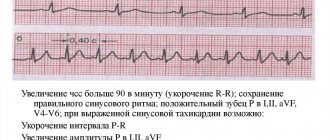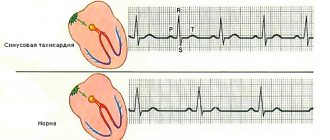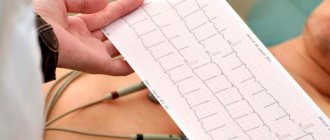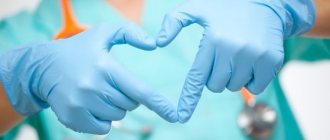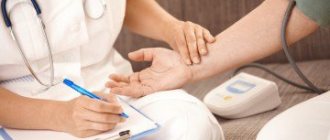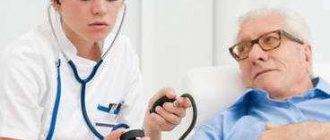Stroke is an extremely serious illness that affects people of all ages.
It ranks first in the list of the most common diseases of the blood vessels and heart.
The risk of occurrence and development of this disease directly depends on a person’s blood pressure.
Weakening of the walls of blood vessels and interruptions in blood circulation to the brain lead to serious consequences (including death or serious disability).
Therefore, it is especially important to check your blood pressure daily, because changed indicators can serve as a signal and prevent a dangerous disease. You should find out what a stroke is before you find out at what pressure a stroke can occur and whether there is a chance of developing a stroke with normal blood pressure.
Letters from our readers
Topic: Grandma's blood pressure has returned to normal!
From: Christina ( [email protected] )
To: Administration otgipertonii.ru
Christina, Moscow
My grandmother’s hypertension is hereditary - most likely, I will have the same problems as I get older.
I accidentally found an article on the Internet that literally saved my grandmother. She was tormented by headaches and had a repeated crisis. I bought the course and monitored the correct treatment.
After 6 weeks she even started talking differently. She said that her head no longer hurts, but she still takes pills for blood pressure. I am sending a link to the article
Causes of highly elevated heart rate
Increased heart rate occurs during any physical activity, heavy mental work, or during periods of emotional instability (both positive and negative). Therefore, to take readings of the heart, you must be in a completely relaxed state, in a quiet environment, without external stimuli. The optimal time for self-monitoring is the morning - 30 minutes after waking up, before breakfast. During this period, the body is just beginning to enter the active stage, so the pulse will reflect the current work of the heart without distortion by natural processes. If, in a calm state, the heart rate is consistently above 90 beats per minute (cumulative data for at least 7 days of monitoring), then it makes sense to worry. A high pulse, the causes of which can be cardiac pathologies, extracardiac (not related to the work of the myocardium) and natural factors (lifestyle, anatomical structure, etc.), requires treatment.
- heart failure;
- myocardial infarction;
- angina pectoris;
- myocarditis;
- cardiomyopathy;
- infective endocarditis;
- adhesive pericarditis.
High pulse causes not related to the cardiovascular system:
- endocrine disorders;
- anemia;
- vascular insufficiency;
- renal colic;
- infectious and inflammatory diseases;
- neurosis;
- cardiopsychoneurosis;
- intoxication.
High pulse is caused by natural (external) origin. The pulse may increase for a short time, and when unfavorable factors are eliminated, the condition stabilizes or does not contradict the individual norm:
- physical activity - with any, even minor movements, the heart rate increases;
- emotional stress - anxiety, irritation, tears, joy and bursts of happiness cause increased heart rate;
- congenital features - the anatomical structure of the body affects all vital processes, the cause may be a genetic pathology or an anomaly of internal organs;
- ambient temperature - the warmer the air and higher the humidity, the faster the heart beats, pumping blood. By the beach season, the pulse of all people becomes high (by 5–8 beats);
- total body weight. Obesity, like dystrophy, does not have the best effect on the functioning of the cardiovascular system. As soon as the weight returns to the physiological norm, the bullet stabilizes;
- bad habits. Smoking, alcohol, and drugs increase the heart rate to a critical state.
The multiple causes that can influence high heart rate make diagnosis difficult. To prevent an increased heart rate from becoming a death sentence, you should be attentive to your own body’s signals and not ignore important symptoms.
Pulse above 90 beats per minute
The danger of elevated heart rate lies in its asymptomatic nature (in many cases). Changes can only be noticed after a targeted pulse check or blood pressure measurement, which is not typical for all people. And only as the tachycardia progresses, the patient notices the appearance of the first symptoms:
- weakness, fatigue;
- rapid, labored breathing;
- dizziness, to the point of fainting;
- feeling of heartbeat in throat, ears.
If a strong pulse quickens to a critical (for an adult, healthy person) 200 beats per minute (or higher), the heartbeat in the chest, even the sound, can be physically felt. Loss of consciousness occurs when the beat frequency is 210 or higher.
Some forms of arrhythmia are characterized by sudden increases in heart rate, for no apparent reason, and the same return to normal. For example, when atrial fibrillation becomes the cause of a rapid pulse (above 90-100 beats min), such a symptom is included in the clinical picture of the disease. If during such surges a person feels pain and tingling in the chest, this is a clear sign of negative processes in the heart, which requires immediate investigation.
Sustained very high pulse - what to do in this case? Increased heart rate and completely normal blood pressure are common in patients with tachycardia. These values are not always connected and dependent on each other. But the absence of signs of hypertension is not an indicator of health, but a masking of serious symptoms associated with heart disease. Only a cardiologist can determine the presence or absence of a problem. There is only one conclusion: if frequent episodes of heart contractions are observed, while discomfort, dizziness, and numbness of the limbs are felt, you should be examined for the presence of cardiac pathologies. If the results are negative, continue to determine the causes of the anomalous condition in other planes.
Diseases with a high risk of thrombosis
Atrial fibrillation
What leads to stroke in atrial fibrillation
In most cases, atrial fibrillation is not a life-threatening condition, since the pumping function of the heart is maintained by contraction of the ventricles. However, patients with atrial fibrillation face dangers associated with blood stagnation in certain parts of the atria. And the most important danger is the threat of blood clots forming in the left atrium, which can travel through the bloodstream into medium and small arteries. Moreover, the “bottleneck” place where such a blood clot is most likely to get stuck is the vessels supplying the brain. As a result, the artery becomes blocked, depriving part of the brain of blood supply. This is an ischemic stroke.
1. Kirchhof P. Auricchio A. Bax J. et al. Outcome parameters for trials in atrial fibrillation: executive summary. Recommendations from a consensus conference organized by the German Atrial Fibrillation Competence NETwork (AFNET) and the European Heart Rhythm Association (EHRA). Eur Heart J 2007; 28:2803–2817.
In addition, blood clots from the left atrium can enter the arteries of the kidneys, spleen, upper and lower extremities.
Atrial fibrillation increases the risk of stroke by 5 times and causes every fifth stroke to occur 1.
2. Friberg L. Hammar N. Rosenqvist M. Stroke in paroxysmal atrial fibrillation: report from the Stockholm Cohort of Atrial Fibrillation. Eur Heart J 2010; 31:967–97
Moreover, paroxysmal atrial fibrillation increases the risk of stroke to the same extent as constant or persistent arrhythmia 2 .
Rice. 1. Ischemic stroke
And ischemic stroke in patients with atrial fibrillation often ends in death and, compared with a stroke of another nature, leads to the most severe disability and is more likely to recur. Accordingly, the risk of death in patients with stroke associated with atrial fibrillation is 2 times higher, and treatment costs increase 1.5 times 3.
Rice. 2. Ischemic stroke in patients with atrial fibrillation leads to more severe disability
3. Stewart S. Hart CL Hole DJ McMurray JJ Population prevalence, incidence, and predictors of atrial fibrillation in the Renfrew/Paisley study. Heart 2001; 86:516–521.
Ischemic stroke risk assessment
The high risk of ischemic stroke in AF has led to a large number of studies assessing risk factors for this complication and developing preventive approaches.
In 2006, a special CHADS2 scale was proposed to calculate the risk of thromboembolic stroke, where C is heart failure, 1 point; H—hypertension, 1 point; A - age over 75 years, 1 point; D—diabetes mellitus, 1 point; S2 - stroke, 2 points.
The number of points when calculating risk correlates with the frequency of strokes per year from 1.9 with 0 points to 4 with 2 points and 18.2 with 6.
4. Camm AJ Kirchhof P. Gregory YH at al. ACC/AHA/ESC 2010 guidelines for the management of patients with atrial fibrillation-executive summary // Eur. Heart J. – 2010. – Vol. 31. – P. 2369-2429.
At the same time, a critical level was determined, after which patients should take anticoagulant therapy for the purpose of prevention - 2 points or more 4.
Diagnostics
When visiting the clinic for the first time, a conversation is held with the patient, which will help to create a reliable anamnesis. A short survey is aimed at finding out the lifestyle, social status, type of activity and the presence of cardiovascular pathologies in close relatives. In this way, a primary connection is established between a constantly elevated heart rate and possible diseases that are conditionally embedded in the patient’s genetics. Determination of the pulse rate is included in the compilation of the clinical picture. To do this, the doctor will ask you to perform several exercises (stress test) or, conversely, sit for 20 minutes in complete peace. If blood pressure does not increase with a high pulse, the situation is prognostically favorable. When hypertension is combined with a rapid pulse, it is less benign.
Inspection. Examination of the patient may indicate other systemic diseases associated with the thyroid gland or other organs. Sometimes swelling of varying degrees of severity is detected. Particular attention is paid to the color of the skin, which in pathological conditions can become pale or cyanotic.
Electrocardiogram. A standard ECG is a key method for examining patients with a rapid heart rate. An ECG provides the most information when performed during an attack (for example, when the heart rate and blood pressure increase), as it can help identify the underlying cause of the disorder, especially if it is related to cardiac pathology.
Laboratory research. Basic blood tests are taken to rule out anemia or electrolyte deficiency. Thyroid function testing may be done or other biomarkers may be tested, anything that affects a high heart rate above 90 beats per minute.
Echocardiography. This is an ultrasound scan of the heart that helps to examine the structure and function of the heart and determine the reasons that increase heart rate. It is often used to assess the performance of valves and determine other parameters of the heart and large vessels nearby.
Electrophysiological study. If using the above diagnostic methods it is not possible to make an accurate diagnosis, then an invasive study in the form of EPI is used. With its help, the presence and nature of cardiac abnormalities can be determined quite accurately.
How to prevent stroke?
To prevent stroke and thrombosis, you need to take Cardiomagnyl.
If atrial fibrillation is diagnosed, the doctor prescribes medications to prevent blood clots and stroke. In 95% of cases, the patient takes drugs of this type (Aspirin, Cardiomagnyl, etc.). The choice of drug should be made by a doctor. This warning is not accidental, since with constant use or an incorrectly selected dosage, the body gradually gets used to the medication, and blood clotting decreases. Therefore, constant monitoring of this indicator is necessary. You should not refuse a blood test prescribed by your doctor. Medicines without side effects have recently appeared on the pharmaceutical market, but they are somewhat more expensive than conventional drugs.
What to take if your heart rate is high
If a constantly high pulse causes discomfort, it is necessary to stabilize the heartbeat, take available remedies and seek medical help. Before arriving (or visiting) a doctor, you must provide first aid to yourself. Take off tight clothes and shoes, and if possible, lie down. Press on the upper eyelids with your fingertips and hold for a few seconds. Even out your breathing - take a deep breath for 5 seconds, exhale for 5 seconds. If you are not dizzy or faint, wash your face with cool running water and drink a glass of soft drink with ice, preferably with sugar.
Even if the condition improves significantly, you should not ignore visiting a doctor. A comprehensive examination will help determine the causes of tachyarrhythmia and prescribe adequate treatment.
Pharmacology will tell you what to do in this condition if your pulse is constantly high. Depending on the degree of the disease, the frequency of symptoms and the physiological characteristics of the body, doctors prescribe therapeutic therapy, which includes taking medications. They must be taken according to a strictly defined regimen and with convincing indications.
All medications that help when a high pulse occurs, above 90 beats per minute, can be classified into three main categories. The table below shows the most effective drugs in each group, as well as their therapeutic effect on the human body. All these medications can be bought at a pharmacy without a prescription (but only as prescribed by a doctor).
| Funds group | Name of drugs | pharmachologic effect |
| Herbal preparations | Valerian extract Peony tincture | Sedative, dilation of blood vessels, stabilization of heart rhythm, elimination of side effects of stress, insomnia, slight antispasmodic effect |
| Membrane stabilizing drugs | Atropine Flecainide | Reduced myocardial excitability, decreased heart rate, slowed conduction in all parts of the heart |
| β-blockers | Propranolol Practolol | Prevents the influence of the sympathetic nervous system on the myocardium and processes that increase heart rate |
Due to the prevalence of tachycardia, people have long learned to relieve unpleasant symptoms when heart rate and/or pressure increase. Universal recipes are passed down from generation to generation. They have not lost their relevance even today. Of course, folk recipes are not a panacea, but they are quite capable of alleviating the pathological condition. Unlike their pharmacy counterparts, tinctures, decoctions, and medicinal teas do not have side effects and do not cause harm. It is strictly forbidden to replace conservative treatment methods with home remedies (if a diagnosis has been made and a treatment regimen has been prescribed). But using it to enhance the effect and as a preventive measure is not prohibited. So, high heart rate, what to do at home.
Red fruits are a classic remedy for all heart diseases, including stabilizing arrhythmias. The tincture has cardiotonic and antispasmodic effects, moderately lowers blood pressure, and calms the nervous system. The combination of medicinal properties, especially in combination with a high content of vitamin C, makes it an important element in complex therapy for cardialgia, neurocirculatory dystonia and other disorders of the heart and blood vessels.
The tincture should be consumed three times a day, 100 ml before meals. You can add 2 tsp to the main hawthorn. horsetail and 3 tsp. knotweed. This combination has an additional positive effect on the nervous system.
The simplest and most accessible recipe based on honey: grind 10 lemons with peel in a blender or meat grinder. Grind 10 heads of garlic to a paste. Add 1 liter jar of honey. Mix all ingredients thoroughly. Infuse the resulting mixture for a week. You need to take the medicinal mixture 2 tbsp. l. 1 per day.
Herbal teas for the heart
You can strengthen the immune and cardiovascular system and eliminate a high pulse (above 90 beats/min) with the help of tasty and healthy teas. Regular use will show visible results within a week.
Recipe 1. Mix 1 tablespoon each of chamomile flowers, valerian root, caraway seeds, fennel seeds. Pour water brought to a boil in the proportions of 2 tablespoons of the mixture per 600 ml of boiling water. Let it brew for 1–1.5 hours, strain through a sieve. Drink 300 ml of tea in one gulp; you can repeat it after 6–8 hours. The course of treatment is 2–3 weeks depending on the patient’s condition.
Recipe 2. Grind the leaves of peppermint, trefoil, and angelica in a blender. Mix gradually in equal proportions. Pour one tablespoon of the mixture into 250 ml of boiled water and put on fire for 5–10 minutes. Let sit for 3-5 hours. Strain and drink 100 ml in small sips 2 times a day. The therapeutic effect will be noticeable after 14 days of regular use.
You can control your heart rate when it rises above 90 beats per minute with a balanced diet. By increasing the amount of foods rich in beneficial microelements in your diet, you can forget about high heart rates forever.
Potato
The beloved vegetable is rich in magnesium and potassium, two microelements that are an important part of a diet that eliminates hypertension and increased body weight. Eating a diet rich in potassium helps the body become more efficient at flushing out excess sodium, the main cause of high heart rate.
Curdled milk
A glass of sour milk provides calcium and vitamin D, as well as other nutrients that help reduce heart rate by 5-15%. Numerous studies have shown that people with low calcium levels have a higher risk of developing cardiovascular disease.
Eggs
Egg whites are effective in lowering heart rate and blood pressure, according to research presented at a meeting of the American Chemical Society. Eggs are a reliable source of protein, vitamin D and other essential nutrients for the body.
Broccoli
The vegetable is a good source of circulatory system-regulating minerals: magnesium, calcium and potassium. A diet based on broccoli dishes can help lower blood pressure and heart rate, and reduce the likelihood of developing cardiovascular diseases and stroke.
Sesame and rice oil
According to research, people who consumed a mixture of two oils available in health food stores had a reduction in blood pressure that was almost comparable to the effect of taking medication. The result is due to the presence of fatty acids in the oils and antioxidants.
Bananas
One banana contains about 420 ml of potassium, which reduces heart rate above normal. This is approximately 11% of the 4,700 milligrams of potassium recommended to be taken each day to avoid adverse cardiovascular conditions. In fact, many vegetables contain more potassium than the delicious and popular fruit. For example, a cup of cooked white beans has 1,200 milligrams, and an avocado has 975 milligrams.
Black chocolate
Rich in antioxidants (flavonoids), which make blood vessels more elastic. To get the benefits of chocolate you need to eat no more than 100 grams per day.
Pomegranate
When an adult drinks 330 ml of pomegranate juice every day for four weeks, their pulse, systolic and diastolic blood pressure decreases. Thus, you can replace orange juice with one and a half glasses of pomegranate juice, and the body will thank you with an even heartbeat, not higher than normal.
What is a stroke
A stroke (also called apoplexy) is a sudden fatal interruption in the blood flow to the brain, due to which the cells of the nervous system are seriously damaged or even die.
It is known that different areas of the brain are responsible for different functions and vital processes, so the location of the stroke determines which functions will be suppressed and to what extent. A stroke develops very rapidly and can be complicated by both external and internal causes.
Don't tolerate high blood pressure
Now hypertension can be cured by restoring blood vessels...
>
Factors that increase the risk of stroke may include:
- increased body weight;
- addiction to alcohol, smoking and drugs;
- external brain injury (eg, concussion);
- advanced age;
- various types of diabetes;
- chronically high blood pressure;
- increased blood clotting.
Types of stroke (they depend on the size of the vascular collapse):
- Hemorrhagic - occurs due to internal damage to the vessel (most often, its rupture). The blood content of the damaged vessel enters the brain cavity, forming a blood clot. It, in turn, increases pressure on the cells, which leads to their death. This species has a high mortality rate.
- Ischemic - occurs due to a decrease in the patency of blood vessels and their blockage. As a result, the saturation of the brain with oxygen, which enters there through the blood, is disrupted. Cell necrosis develops from lack of oxygen.
What are the symptoms to identify a stroke?
- general weakness, unsteady gait;
- depression of consciousness and speech;
- headache;
- disturbance of the sense of balance, unilateral paralysis of both limbs and facial muscles may occur.
Preventing high heart rate
To ensure that the pulse is always within a comfortable norm (not higher, not lower), cardiologists recommend adhering to simple but effective rules:
- Avoid caffeinated drinks. Coffee in the morning, and then throughout the day, stimulates the heart rate just as well as a good run;
- limit the consumption of alcoholic beverages, and if addiction exists, undergo a full course of rehabilitation - this will significantly increase the quality and length of life;
- review your diet in favor of healthy foods and a strict eating regimen. Avoid snacking before bed;
- provide yourself with feasible physical activity and daily exposure to fresh air;
- learn to approach stressful and conflict situations with detachment, without perceiving them as insoluble problems;
- organize an optimal work-rest ratio.
Of course, long-term habits are difficult to eradicate. But by turning to loved ones or professional doctors for help, you can completely change your life in a month. This will affect not only the pulse, but also the worldview, radically replacing concepts with better ones.
Pulse readings are very important in determining a person's health status. They indicate possible abnormalities in the functioning of the heart, blood vessels and throughout the body. The cause of a high heart rate may be a stressful situation or a violation of acceptable physical activity. But in some cases, such a phenomenon signals serious pathological changes that require immediate examination and subsequent treatment.
What heart rate is considered high?
It is unlikely that a healthy person would be bothered by this issue.
But you should know that 60 to 90 beats per minute is considered normal. The frequency largely depends on the functioning of the body's systems, as well as on age and occupation. For example, women have 6-9 more strokes than men of the same age group. In athletes, these indicators can be 40-50 units, since the heart muscle is quite well developed. Intensive metabolism in children under one year old explains the high rates - 120-140. With age, the frequency of oscillations gradually changes in a child, at 14 years old it reaches 75-85 beats within 60 seconds. For older people, the pulse may be below 60.
At any age (except for children), a pulse above 90 indicates tachycardia, that is, the inability of the heart muscle to carry out normal blood circulation. A pulse exceeding 120 beats is considered especially dangerous. Such manifestations should be a reason to consult a doctor in order to prevent the development of complex diseases.
Difference between fast and high heart rate
Patients often complain that their heart rate is high.
These concepts should be distinguished. The cause of frequent blows can be overexertion and even the time of day. For example, the morning pulse is 20 units lower than the evening one. At rest it is also less than after physical activity. You should not be alarmed - this is normal. But inflated numbers in the morning are an indicator of a serious illness and require a thorough examination.
In addition to frequency, some other characteristics are taken into account when assessing the heartbeat:
- The rhythm that changes during the measurement process is called arrhythmia. In order to obtain accurate data, it is necessary to observe the rhythm for a minute.
- Filling depending on the stroke capacity of the heart. Poor pulse hearing is evidence of heart failure.
- Voltage depending on blood pressure readings.
- Height - records vibrations of the wall of the cardiac artery and may indicate aortic valve dysfunction.
Temporary deviations of beats from the norm, caused by physical or emotional stress, speak only of physiological tachycardia. It goes away when stress factors and fatigue are eliminated. But a constantly high pulse is a signal about the need to identify the cause and undergo an examination. Most likely, there is a blood pressure disorder. Although sometimes this is due to the individual characteristics of the patient.
Low heart rate after stroke
A temporary decrease in heart rate may be associated with uncontrolled use of beta blockers - drugs to lower blood pressure. Strokes often develop against the background of hypertensive crises. To reduce blood pressure and maintain it at an optimal level, various drugs are used, including beta blockers. Their side effect is a decrease in heart rate.
A low pulse after a stroke may be a manifestation of damage to the brain stem and the regulatory centers located in it. Dysfunction of the vasomotor center is characterized by uncontrolled alternation of episodes of normal pulse with tachy- or bradyarrhythmia.
Sick sinus syndrome (SSNS) is common after a stroke. This leads to its inability to perform the function of a pacemaker, which can be clinically manifested by a decrease in heart rate.
SSSS can be either transient (due to disruptions in nervous regulation) or permanent (organic dysfunction). The loss of the sinus node’s control function leads to the development of the following types of secondary arrhythmias4:
- atrioventricular block;
- replacement rhythms;
- migration of the supraventricular pacemaker.
A pronounced decrease in pulse rate in the acute period of stroke may indicate an increase in intracranial pressure against the background of hemorrhagic stroke and ischemic brain damage. Hemorrhage in the brain most often occurs during a hypertensive crisis, accompanied by a sharp spasm of intracerebral vessels.
Causes
If the pulse is high and is not provoked by temporary factors (physical activity, stressful events), measures should be taken immediately to identify the causes of the high pulse. Among them are serious diseases:
- myocardial damage in various heart diseases, including coronary artery disease, myocardial infarction, heart failure, cardiomyopathies, tumors and myocarditis;
- the presence of pathological pathways for conducting electrical impulses in the heart;
- congenital heart defects;
- anemia;
- hyperthyroidism – overactive thyroid gland;
- high or low blood pressure;
- imbalance of electrolytes, which are necessary for conducting impulses in the heart;
- increased body temperature;
- external or internal bleeding;
- dehydration of the body;
- lung diseases.
The listed diseases and causes of rapid heartbeat are closely interrelated due to the influence of the former on the speed of blood movement, which causes an increase in heart rate.
A high pulse is not exclusively a consequence of pathological conditions. They can be triggered by various medications:
- sedatives - Amitriptyline, Elivel, Saroten;
- diuretics – Cyclomethiazide, Diacarb, Lasix;
- glycosides – Digoxin, Strophanthin, Bibliorg;
- drugs that promote vasoconstriction during a runny nose - Tizin, Sanorin, Naphthyzin.
Many bad habits and thoughtless actions can provoke high rates. Among them, special mention should be made:
- use of drugs and hallucinogens;
- abuse of tea, coffee, cigarettes, alcohol;
- overeating, tendency to eat fatty, fried, spicy foods;
- inability to cope with a stressful situation, anxiety, fear, prolonged exposure to the sun in hot weather; hard labour.
It is impossible to list all the reasons for an increase in heart rate, but if there is a constant tendency to some of them, the situation threatens to result in serious health problems.
Treatment methods
To treat atrial fibrillation, you need to prescribe a set of medications that solve the following problems:
- restoration of rhythm - Novocainamide, intravenous Cordarone, Ritmonorm;
- prevention of attack recurrence - Cordarone tablets, Propanorma for course use;
- contraction frequency control – Digoxin, Isoptin, Anaprilin;
- prevention of thromboembolism - Warfarin, Curantil, Tiklid, Aspirin.
Read also: You can have sex if you have arrhythmia
In the event that attacks of flicker are frequent, then to completely eliminate the source of the rhythm disturbance, the focus of pathological excitation is isolated. To do this, radiofrequency waves act on the mouths of the pulmonary veins or cauterize part of the myocardium in the area of the atrioventricular node. In this case, a complete blockade of impulse conduction occurs, requiring the installation of a pacemaker operating in constant mode.
Watch the video about the treatment of cardiac arrhythmia:
Characteristic symptoms
With a high pulse rate, the heart loses its ability to supply blood to all parts of the body, which negatively affects the supply of organs and tissues with sufficient oxygen. This situation is accompanied by the following symptoms.
- In some cases, this may be a slight discomfort, in which the patient is not particularly concerned about the question of why his pulse is elevated and what to do.
- There is a rapid heartbeat, accompanied by clearly felt tremors in the chest area.
- There may be no painful sensations, but there is a feeling of anxiety and fear of such manifestations, especially at night. Such attacks do not last long, then the heart continues to work calmly. Frequent companions are dizziness, headache, hot flashes.
- A high pulse can be felt in several parts of the body. These symptoms frighten the patient very much and provoke insomnia and night terrors.
It should be remembered: if the pulse is constantly high, this is most likely due to pathological changes. They require immediate identification of the disease that contributes to the manifestation of the listed symptoms.
How is atrial fibrillation treated?
In half of the cases, attacks occur without any symptoms. If an attack lasts 2 days or more, the risk of thrombosis increases sharply. A third of asymptomatic attacks last more than 48 hours. This disease cannot be completely cured. The treatment strategy is divided into 2 types. The first is aimed at normalizing and equalizing sinus rhythm. With the second strategy, the heart rate is reduced, that is, the atrial fibrillation type remains, but due to the decrease in intensity, the patient does not feel its manifestations. The doctor decides which path to choose.
Read also: Arrhythmia in pregnant women
Elimination of symptoms occurs with the help of medications or catheter ablation - surgery. Medicines are effective in half of the cases, surgery helps in 75%.
Possible complications
To avoid irreversible consequences, everyone should know the dangers of a high heart rate. Regardless of the cause of the increased heart rate, the presence of high rates can provoke:
- the formation of blood clots in the heart cavity, which is dangerous for the development of a stroke;
- cardiac ventricular failure;
- arrhythmic shock;
- syncope;
- sudden death due to cardiac arrest.
All diseases are quite serious. Therefore, at the first symptoms, you should not talk about what to do with a high pulse and haphazardly swallow pills, but get examined immediately. This way you can prevent severe pathological diseases.
Therapeutic course
Treatment for high heart rate involves eliminating the causes that caused it.
For this purpose, the cardiologist will advise you to undergo a medical examination, which will become the basis for prescribing drug therapy to help slow down the heart rate. To minimize complications caused by a high pulse, as well as to prevent its recurrence, you should consult a doctor who can recommend simple exercises that help restore normal heart rhythm during an attack of tachycardia. To do this, you can use vagal maneuvers - simply cough while leaning forward, or put an ice pack on your face.
Among the drugs, sedatives such as Corvalol, Valocordin, Valoserdin have proven themselves well. Pharmacy infusions of valerian and motherwort also help normalize the rhythm.
If it is impossible to regulate the frequency of beats with these simple maneuvers and the above means, the therapist will prescribe antiarrhythmic drugs. The treatment course is prescribed in the form of tablets or injections.
It should be borne in mind that the use of tablets requires their regular use and dosage prescribed by a doctor.
If there is no positive result after drug treatment, electropulse therapy is performed.
In exceptional cases, when the condition does not improve, they resort to implantation of a special device that adjusts the rhythm - a pacemaker or pacemaker. This is a small, sensitive device implanted under the skin. Using electrical impulses, it helps restore rhythm.
If life-threatening symptoms are present, implantation of a cardioverter-defibrillator is recommended.
Surgery is used in particularly severe cases when other types of treatment do not produce positive results.
The treatment course is prescribed based on the medical history, taking into account the individual characteristics of the patient. Self-medication can lead to the opposite result - blurring the picture of the disease, which will complicate further recovery.
Treatment of arrhythmia and stroke
After assessing the patient's current condition, the attending physician decides to either use medication or surgery (ablation to interrupt the impulse leading to the disease). To minimize the risk of stroke, the drug Apixaban is prescribed, which is also effective after surgery. The antiplatelet effect is achieved by taking the medicine "Dabigatran" and "Warfarin", "Warfarin", "Curantil", "Tiklid". Therapy for atrial fibrillation and ischemic stroke is intended to solve a complex of problems. To restore cardiac ri (intravenously), “Ri. Digoxin, Isoptin, and Anaprilin help control the frequency of contractions. To prevent recurrent attacks, you need to take “Propanorm” and “Cordarone” tablets.
Preventive actions
To get rid of night fears: “Why is your pulse high?”, you need to listen to the doctor’s advice, not self-medicate, and lead a healthy lifestyle that excludes bad habits: smoking, drug use, alcohol.
In addition, avoid weight gain, maintain normal blood pressure and cholesterol levels, and regularly undergo routine examinations. Pay special attention to proper nutrition, moderation in the consumption of fatty, spicy, fried foods. Learn to cope with stress, engage in physical exercise, but dose the load according to age characteristics.
A problematic situation can be prevented or corrected if you follow these tips and promptly contact specialists if a high pulse occurs.
The prognosis is comforting only if the problems that arise are taken seriously; otherwise, serious pathological changes that are difficult to treat may develop.
